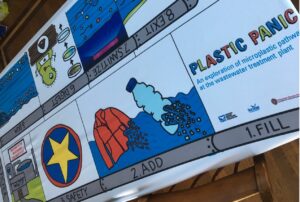A grab and go teaching kit
Updated Summer 2023!
Model the journey water takes at a Wastewater Treatment Plant (WWTP) through a series of hands-on steps around a tabletop model. Learn about our microplastic pollution problem, and discover what happens to the pollutants as they enter and pass through a WWTP. The kit with the tabletop model is available for loan. Fill out the form below.
 Key Lessons and Background
Key Lessons and Background
What are microplastics?
Microplastics are plastic particles 5 mm or smaller.
Where are microplastics coming from?
Microplastics are often thought about in two groups: Primary microplastics are those that are deliberately made (ex. small pellets for filling stuffed animals, beads added to face wash and personal care products). Secondary microplastics are formed by degradation of larger plastic products. Tires wearing on roads and fibers shed from synthetic clothing during laundering are two common sources of these secondary microplastics.
What happens at the WWTP?
Wastewater treatment plants are complex and employ a variety of different methods to clean our water (mechanical, chemical, biological). However, these plants aren’t designed to filter out microplastics. While some microplastics may be removed during the treatment process, others may pass through WWTPs and be released into the natural environment along with the cleaned water, called “effluent.” Additionally, some of the microplastics that are captured and removed from the water are concentrated in sewerage “sludge” that is sometimes sold to farmers and spread on fields as fertilizers. Public and scientific awareness of microplastics is increasing and much research needs to be done to fully understand the impact of microplastics may have on a wide range of organisms and ecosystems. As of 2019, “No specific treatment process aimed at microplastics removal has been applied in any full-scale WWTP yet and the microplastics-targeted treatment technology is still at the preliminary research state” (Sun 2019).
What’s so bad about microplastics?
Fish and other organisms sometimes mistake microplastics for food. A belly full of plastic can make them feel full without providing any nutritional value. Additionally, heavy metals and other pollutants tend to be attracted to and stick to plastics. These can be harmful to the organism that ingests the plastic, and they can work their way up the food chain.
For: All
Topic: Plastics and Wastewater treatment
- Plastic Panic Educator’s Guide
- Activity Sheets
- Extensions
- Borrow a Plastic Panic! Kit
Originally developed fall 2019 in collaboration with the Chazen Museum of Art. Updated summer 2023. This activity is based on research by Derek Ho, biological systems engineering Ph.D. student under Troy Runge, UW–Madison. Artwork by Chelsea Mamott, Wisconsin Energy Institute digital media specialist.
Development of the Plastic Panic kit was supported by the Center for Great Lakes Literacy and the National Oceanic and Atmospheric Administration, through the Great Lakes Restoration Initiative.







